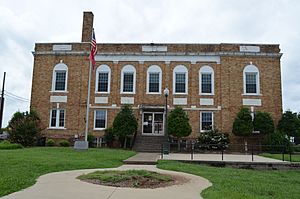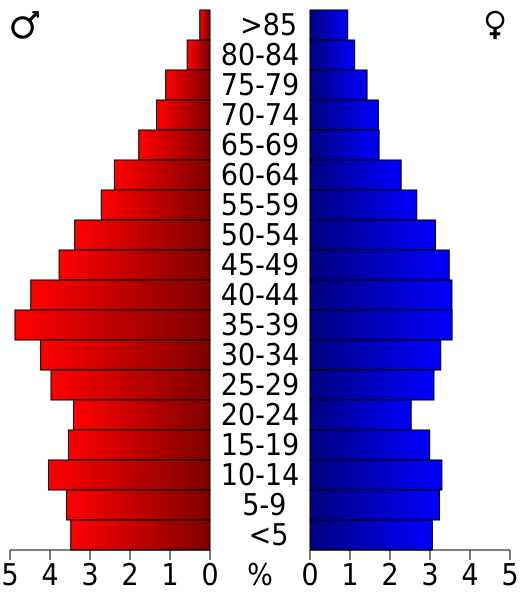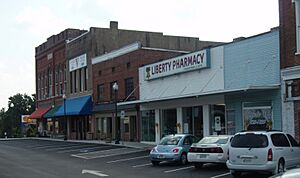Hickman County, Tennessee facts for kids
Quick facts for kids
Hickman County
|
|
|---|---|

Hickman County Courthouse in Centerville
|
|

Location within the U.S. state of Tennessee
|
|
 Tennessee's location within the U.S. |
|
| Country | |
| State | |
| Founded | 1807 |
| Named for | Edwin Hickman, explorer |
| Seat | Centerville |
| Largest town | Centerville |
| Area | |
| • Total | 613 sq mi (1,590 km2) |
| • Land | 612 sq mi (1,590 km2) |
| • Water | 0.1 sq mi (0.3 km2) 0.02%% |
| Population
(2020)
|
|
| • Total | 24,925 |
| • Density | 40/sq mi (20/km2) |
| Time zone | UTC−6 (Central) |
| • Summer (DST) | UTC−5 (CDT) |
| ZIP Codes |
37033, 37098, 37025, 37137, 37097, 38487, 38454, 38476, 37140
|
| Area code | 931 |
| Congressional district | 7th |
Hickman County is a county located in the state of Tennessee in the United States. In 2020, about 24,925 people lived here. The main town and county seat is Centerville. Hickman County is part of the larger Nashville metropolitan area.
Contents
History of Hickman County
Hickman County was named after Edwin Hickman. He was an explorer and surveyor who helped map out new lands. Sadly, he was killed in an attack by Native Americans in 1791.
The county was officially created in 1807. Robert Weakley, a lawmaker who had traveled with Edwin Hickman, suggested naming it after him. The county was very large at first. Over time, parts of it were used to form other counties like Wayne, Lawrence, Perry, and Lewis.
The land around Hickman County and the Duck River valley originally belonged to the Chickasaw people. One of the first European settlers was John Gordon. He was known as "Captain of the Spies" and fought alongside Andrew Jackson in battles.
John Gordon bought land by the Duck River. He worked with Chief William "Chooshemataha" Colbert. Together, they ran a ferry and a trading post for settlers. This helped people traveling on the Natchez Trace, an old path that became a road. The Chickasaw people gave up this land in 1805. Gordon kept his property and built a large farm. His house, the Gordon House, is still there today. It is looked after by the Natchez Trace National Parkway.
During the 1800s, the county was known for its iron furnaces. These furnaces used the area's natural supply of high-quality iron ore. Some furnaces, like Napier's, were destroyed during the Civil War.
Many famous people have come from Hickman County. These include songwriter Beth Slater Whitson and Grand Ole Opry star Minnie Pearl. William F. Lyell was a soldier who received the Medal of Honor for his bravery during the Korean War.
Hickman County is even mentioned in songs! Johnny Cash sang "Saturday Night In Hickman County." The community of Grinder's Switch is also mentioned in "The South's Gonna Do It Again" by the Charlie Daniels Band.
In 1939, the Meriwether Lewis Electric Cooperative was started in Centerville. It helps provide electricity to the area.
Geography of Hickman County
Hickman County covers about 613 square miles. Most of this is land, with only a small amount of water. The Duck River and the Piney River flow through the county. Many smaller creeks also run through the area.
Neighboring Counties
Hickman County shares borders with these other counties:
- Dickson County (to the north)
- Williamson County (to the east)
- Maury County (to the southeast)
- Lewis County (to the south)
- Perry County (to the west)
- Humphreys County (to the northwest)
Protected Natural Areas
The county has parts of a national park area:
- Natchez Trace Parkway
It also has state-protected areas:
- Beaver Dam Creek Wildlife Management Area
- MTSU Wildlife Management Area
- John Noel State Natural Area
Rivers and Streams
Here are some of the main waterways in Hickman County:
- Duck River
- Piney River
- Panther Branch
- Buck Branch
Population and People
| Historical population | |||
|---|---|---|---|
| Census | Pop. | %± | |
| 1810 | 2,583 | — | |
| 1820 | 6,080 | 135.4% | |
| 1830 | 8,119 | 33.5% | |
| 1840 | 8,618 | 6.1% | |
| 1850 | 9,397 | 9.0% | |
| 1860 | 9,312 | −0.9% | |
| 1870 | 9,856 | 5.8% | |
| 1880 | 12,095 | 22.7% | |
| 1890 | 14,499 | 19.9% | |
| 1900 | 16,367 | 12.9% | |
| 1910 | 16,527 | 1.0% | |
| 1920 | 16,216 | −1.9% | |
| 1930 | 13,613 | −16.1% | |
| 1940 | 14,873 | 9.3% | |
| 1950 | 13,353 | −10.2% | |
| 1960 | 11,862 | −11.2% | |
| 1970 | 12,096 | 2.0% | |
| 1980 | 15,151 | 25.3% | |
| 1990 | 16,754 | 10.6% | |
| 2000 | 22,295 | 33.1% | |
| 2010 | 24,690 | 10.7% | |
| 2020 | 24,925 | 1.0% | |
| U.S. Decennial Census 1790–1960 1900–1990 1990–2000 2010–2014 |
|||
 |
The population of Hickman County has changed a lot over the years. You can see how it has grown in the chart above.
2020 Census Information
| Race | Number | Percentage |
|---|---|---|
| White (not Hispanic) | 22,086 | 88.61% |
| Black or African American (not Hispanic) | 931 | 3.74% |
| Native American | 101 | 0.41% |
| Asian | 72 | 0.29% |
| Pacific Islander | 1 | 0.0% |
| Other/Mixed | 1,053 | 4.22% |
| Hispanic or Latino | 681 | 2.73% |
In 2020, there were 24,925 people living in Hickman County. There were 8,636 households and 5,611 families.
Communities in Hickman County
Town
Census-designated places
These are areas that are like towns but are not officially incorporated:
Unincorporated communities
These are smaller communities that are not officially part of a town or city:
See also
 In Spanish: Condado de Hickman (Tennessee) para niños
In Spanish: Condado de Hickman (Tennessee) para niños


